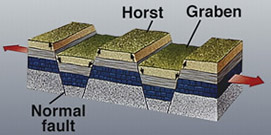Horst (geology): Difference between revisions
Hairy Dude (talk | contribs) rm dablink - title is not ambiguous |
→See also: plateau as there are many similar geological terms |
||
| Line 12: | Line 12: | ||
*[[Fault-block mountain]] |
*[[Fault-block mountain]] |
||
*[[Graben]] |
*[[Graben]] |
||
*[[Plateau]] |
|||
==References== |
==References== |
||
Revision as of 14:04, 24 February 2010

In physical geography and geology, a horst is the raised fault block bounded by normal faults or graben. A horst is formed from extension of the Earth's crust. The raised block is a portion of the crust that generally remains stationary or is uplifted while the land has dropped on either side.
The Vosges Mountains in France and Black Forest in Germany are examples of horsts, the Table, Jura and the Dôle mountains are results of the latter. The word is also applied to those larger areas, such as the Russian plain, Arabia, India and Central South Africa, where the continent remains stable, with horizontal table-land stratification, in distinction to folded regions such as the Eurasian chains.
Horsts and hydrocarbon exploration
In many rift basins around the world, the vast majority of discovered hydrocarbons are found in conventional traps associated with horsts. For example, much of the petroleum found in the Sirte Basin in Libya (of the order of tens of billions of barrels of reserves) are found on large horst blocks such as the Zelten Platform and the Dahra Platform and on smaller horsts such as the Gialo High and the Bu-Attifel Ridge.
See also
References
- This article incorporates text from a publication now in the public domain: Chisholm, Hugh, ed. (1911). Encyclopædia Britannica (11th ed.). Cambridge University Press.
{{cite encyclopedia}}: Missing or empty|title=(help)
